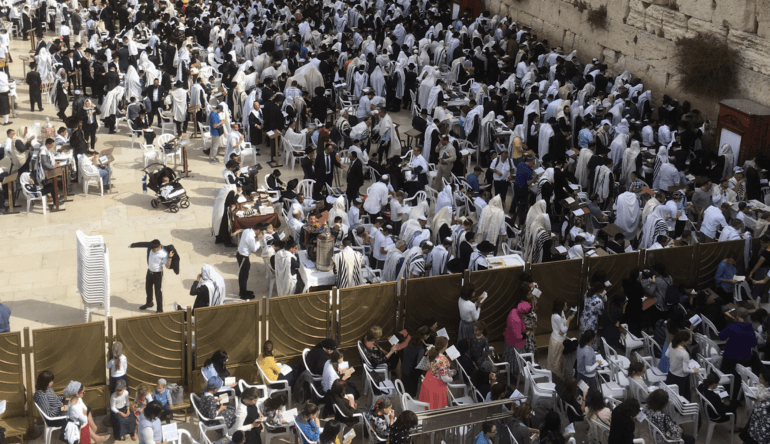
How Much Separation Does Halacha Require Between Men and Women?
Dear Jew in the City,
How much separation does halacha require between men and women?
Best,
Jacob
Dear Jacob,
Thanks for your question. The answer is both objective and subjective.
First let’s establish that separating the genders, at least on some occasions, is not a modern, Medieval, or even Talmudic innovation. It was practiced even in Biblical times, as is evident from a number of sources in Tanach. Perhaps the best known is the song at the sea, in which Miriam led the women in song separate from the men (Exodus chapter 15).
Another Biblical source for the concept of segregating the genders at certain times is found in Zechariah 12:12. This verse refers to men mourning in one group and women mourning in another group. Keep this verse in mind; we’ll come back to it in a second.
The Talmud in Sukkah (51a-b) discusses a problem with frivolity in the Temple. You see, the women originally sat on the inside in the Temple, while the men sat on the outside. This led to levity, so it was changed so that the women sat on the outside and the men sat on the inside. That still led to levity, so it was changed again so that the women sat in an upper gallery and the men sat below. The Talmud uses the aforementioned verse from Zechariah (about men and women mourning in separate groups) to determine that if the genders separate at a time of mourning, when frivolous behavior is not likely to occur, then they should certainly separate at a time when inappropriate behavior such as flirting is likely.
This separation of the sexes in the Temple is the basis for our practice to separate the sexes in shul. Some might find it counterintuitive to think of a shul as a place where frivolity and flirting are likely to occur, but I think many others would not be surprised at all!
Here’s one more Biblical source: Psalms 148:12-13 says, “Young men and also maidens, the elderly with the young, let them praise the name of God….” You’ll notice that the verse says that the young should praise Hashem with the elderly, but that young men and also maidens should praise Him (i.e., they should both do it, just separately). There’s no reason for people of different ages not to praise Hashem together, but it’s appropriate for the sexes to participate separately, even in such a lofty activity.
There’s a prohibition called yichud (seclusion), which prohibits a man and a woman who are not a married couple (or certain close relatives) from being alone together. According to the Talmud (Sanhedrin 21b), this law was instituted by King David after the rape of Tamar by Amnon, as recounted in II Samuel chapter 13.
The Talmud in Kiddushin (81a) discusses the lengths to which the Sages went in order to prevent situations of yichud from arising in public gatherings. Rav Kahana was afraid that if men were in the inner room and women were in the outer room, yichud was likely to occur. (Rashi says this was because the men would have to pass through the outer room to come and go.) A braisa (a statement contemporary with the Mishna), on the other hand, was concerned with men in the outer room and women in the inner room. (Rashi says because one of the men could slip into the inner room undetected.) Since there were reasons to be concerned about both arrangements, the various Sages set up mechitzos (partitions) at their lectures, at weddings and in other places where both men and women gathered.
From here we see the source to separate the sexes in a lot of contexts, including shul, weddings, Torah lectures, and even schools. But if you get around, you’ll notice a lot of other contexts that some communities embrace while others don’t. I’ve been to weddings in Brooklyn where men and women used separate entrances, a village in New York State where men and women walk on opposite sides of the street, and a supermarket in Israel that had separate check-out lines for men and women. These may not be widespread practices, but they’re the practices of these communities, and that makes them legitimate.
You see, there are Biblical laws, and there are rabbinic laws, but there are also gray areas that are left up to a community’s discretion. For example, in some communities, the accepted practice might be for women to wear opaque stockings with seams in the back. In other communities the practice might be to wear regular tights of, say, 80 denier. Still other communities might accept sheer “nude” pantyhose, knee socks, or even ankle socks. And, of course, there are those communities where it’s considered perfectly acceptable for women to be bare-legged below the knee. All of these practices are halachically valid and binding within their respective communities.
(Two notes at this point: 1. A “community” for this purpose might be geographic or it might be philosophical. For example, the city of Meah Shearim has signs clearly expressing the locals’ expectations of visitors. On the other hand, if you affiliate with a certain Hasidic sect, you’re bound by their community standards wherever you go. 2. I’m probably asking for trouble by using an example from the laws of tzniyus – modesty. I could have used standing vs. sitting for the repetition of Shemoneh Esrei or whether or not to eat gebrukhts – matzah that was soaked in water – on Passover. The reality is that those are binary yes-or-no examples, while the tzniyus example gave us a nice spectrum of differing practices.)
Allow me to explain why it’s okay for different communities to adopt different standards.
Imagine three eight-year-old classmates. We’ll call them Alex, Bradley and Charlie. Alex’s bedtime is 8:30 PM, Bradley’s is 9:00, and Charlie’s is a staggering 9:30!
Now, how is this possible? After all, they’re all in the same class! The reality is that each home has the right to set their own rules. Each family knows their own kids, and the circumstances they’re dealing with. Each parent may subscribe to different theories as to how to raise their children. A teacher might think that Charlie’s parents are too permissive, or that Alex’s are way too strict, but no one is going to argue with the right of parents to set their kids’ bedtimes.
It is possible, however, for things to be taken too far. For example, let’s say that Alex, Bradley and Charlie have a classmate named David, whose parents enforce a strict “lights out by 2:30 AM” rule. Not only might the teacher have something to say about that, it’s quite possible that family court might have an opinion on the matter.
Similarly, it’s possible for individuals – or, rarely, a community – to adopt standards that might be considered “out of bounds” by others. For example, certain communities have adopted a practice not to allow depictions of women in their publications. A number of prominent Torah authorities have decried this practice as lacking any basis in halacha and potentially harmful.
But that’s an extreme situation. In most cases, our rule of thumb is “live and let live” and “when in Rome….” Practices may differ widely, but for the most part we respect one another and act accordingly when on someone else’s turf.
Bottom line, community standards are a legitimate component of halacha. How far the separation of the sexes goes largely depends on where you ask the question.
Sincerely,
Rabbi Jack Abramowitz
Educational Correspondent
Follow Ask Rabbi Jack on YouTube
Featured image credit: Wikimedia Commons
If you found this content meaningful and want to help further our mission through our Keter, Makom, and Tikun branches, please consider becoming a Change Maker today.









